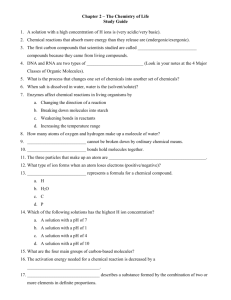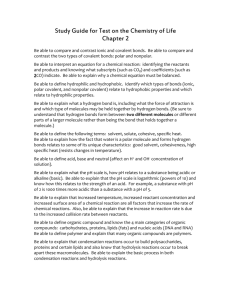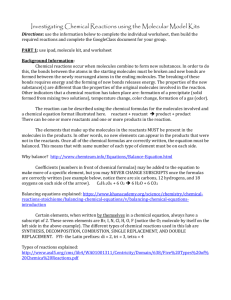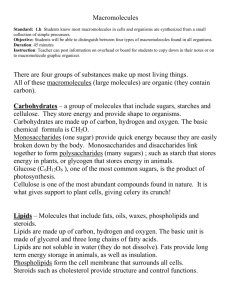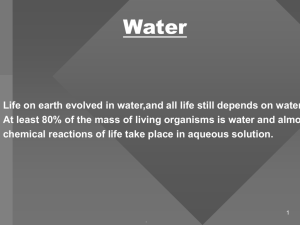File
advertisement
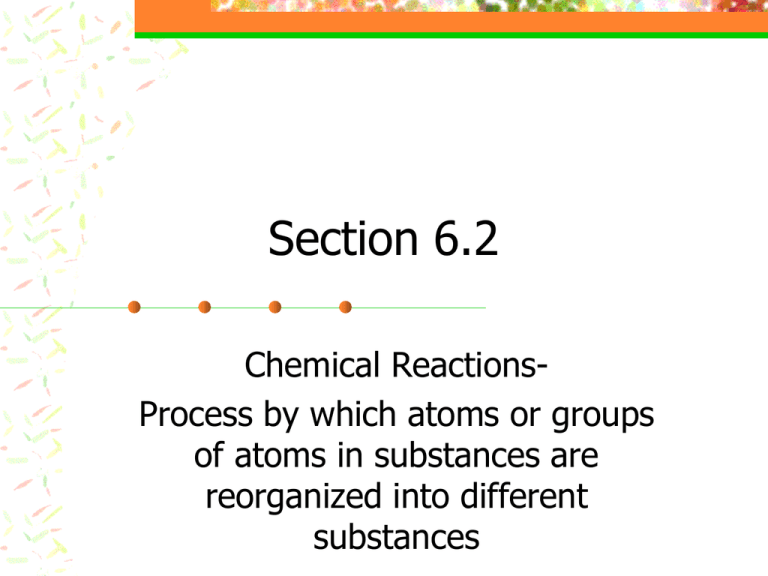
Section 6.2 Chemical ReactionsProcess by which atoms or groups of atoms in substances are reorganized into different substances Reactants and Products Reactants – starting materials Product – ending materials Left side of equation Right side of the equation Arrow indicate process of change Chemical Reaction Reactants are reorganized into different substances Na + Cl ------ NaCl Chemical bonds are broken and reformed C6H12O6 + O2 ------ CO2 + H2O Which is a Chemical Reaction Rust on a chain Water boiling Wood burning Plant production of glucose Candle melting Energy of Reactants Activation Energy – the smallest amount of energy reactants need to make products Exothermic Energy is released as heat or light Heat confirms a chemical reaction Energy of products is LOWER than that of reactants Examples Hand Warmers Fire Glowsticks Cell Respiration Endothermic Heat energy is absorbed Energy of products is HIGHER than that of reactants Examples Photosynthesis Ice Melting Sweat evaporation Cooking Catalyst Catalysts lower the activation energy Not as much energy is needed to form products Chemical reactions can happen FASTER Does NOT increase how much product is made and it does not get used up in the reaction Enzyme Are BIOLOGICAL CATALYSTS Lower activation energy Speed up chemical process in living organsims Enzymes The reactants that bind to the enzyme are called substrates. The specific location where a substrate binds on an enzyme is called the active site. Substrate and active site have complementary shapes and allows them to act much like puzzle pieces Section 6.3 Water and Solutions Water’s Polarity Molecules that have a positive pole and a negative pole, this is called a polar molecule If opposite poles of different molecules come close together they will attract. This attraction leads to hydrogen bonds – weak interaction between a hydrogen and fluorine, oxygen or nitrogen Water One molecule of water has two covalent bonds One bonding the oxygen to each of the hydrogens Multiple molecules of water are held together by hydrogen bonds between the hydrogen on one molecule and the oxygen of another Hydrogen Bond Where are the electrons? To which atom are most located nearest? Mixtures with Water A mixture two or more substance where each keeps its characteristics. A solution is a mixture that has a uniform composition throughout. A solvent is a substance in which another substance is dissolved. A solute is the substance that is dissolved in the solvent. Solution or Mixture Solution or Mixture Section 6.4 The Building Blocks of Life Organic Chemistry The element carbon is a component of almost all biological molecules. Carbon Carbon compounds can be in the shape of straight chains, branched chains, and rings. Macromolecules Carbon atoms can be joined to form carbon molecules. Macromolecules are large molecules formed by joining smaller organic molecules together. Polymers are molecules made from repeating units of identical or nearly identical compounds linked together by a series of covalent bonds. Biological Macromolecules pg 167 Group Example Function Carbohydrates Glycogen Energy source Structural support Lipids Fats Store energy Provide barriers Proteins Hemoglobin – protein which carries oxygen throughout the body Transport Speed reactions Structural support Make hormones Nucleic Acids Building block of DNA Store and communicate genetic information Carbon (Organic) Compounds Carbohydrates- compounds of life made of C, H and O in a 1:2:1 ratio Monosaccharides: single sugar Polysaccharides: many monosaccharides Importance of Carbohydrates to life main energy source of all cells- glucose (C6H12O6) energy storage in plant cells- starch energy storage in animal cells- glycogen cell walls of plants- cellulose Lipids Lipids- compounds of life made of lots of C & H (fats, oils, waxes) Most lipids do not dissolve well in water (covalent bonds) Importance of lipids to life: long term energy storage provide structure of cell membranes chemical messengers: steroids like estrogen, testosterone, and cholesterol. Proteins Proteins- Compounds of life made of nitrogen, C, O and H Held together by polarity of water, hydrogen bonds and interactions of Amino Acids Amino Acids: building blocks of proteins Importance of proteins to life: body structure: muscles, bone, collagen, cartilage, hair transport: hemoglobin- red chemical in blood to transport oxygen fight diseases: antibodies, control chemical reactions: enzymes Nucleic AcidsNucleotides- composed of a sugar, a base and a phosphate Importance of nucleic acids to life: store and move hereditary or genetic information within all cells DNA- two strands that spiral around each other stores hereditary information RNA- one single strand manufactures proteins acts as an enzyme ATP- single nucleotide with two extra energy storing phosphate groups (stores energy temporarily)
